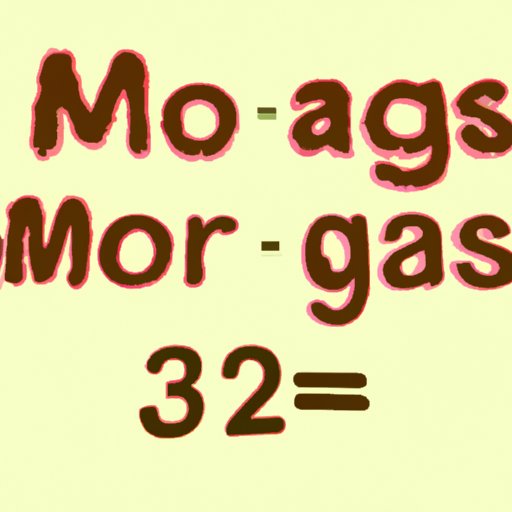
Introduction
Have you ever had to calculate the number of moles in a substance? If so, you may have wondered where to begin. Calculating moles in grams is an essential concept in chemistry, and it’s important to understand how to do it. In this article, we will cover the basics of finding moles in grams, including a step-by-step guide, a formula-based guide, example-based guide, case studies, and quick tips. By the end of this article, you will be able to confidently calculate moles in grams on your own!
Step-by-Step Guide
To find moles in grams, we need to understand the relationship between moles, mass, and molar mass. We can find the number of moles of a substance by dividing the mass of the substance by its molar mass.
Here’s the step-by-step approach:
- Identify the substance you want to find the moles of.
- Determine the mass of the substance.
- Fine the molar mass of the substance.
- Divide the mass of the substance by its molar mass to get the number of moles.
For example, let’s find the number of moles of NaCl in 35 grams of NaCl.
- The substance is NaCl.
- The mass of NaCl is 35 grams.
- The molar mass of NaCl is 58.44 grams per mole.
- Divide 35 grams by 58.44 grams/mol to get 0.599 moles of NaCl.
Formula-Based Guide
The formula relating moles, mass, and molar mass is:
moles = mass / molar mass
where:
- moles is the number of moles of the substance
- mass is the mass of the substance in grams
- molar mass is the mass of one mole of the substance in grams per mole
To use this formula, simply plug in the values you know and solve for the unknown value. Here’s an example:
Calculate the mass of 2 moles of carbon dioxide, CO2.
- The substance is CO2.
- We know the number of moles is 2.
- The molar mass of CO2 is 44.01 grams per mole.
- Plug in the values: 2 moles = mass / 44.01 grams/mol.
- Multiply both sides by 44.01 grams/mol to get mass = 88.02 grams.
Example-Based Guide
Let’s take a look at some examples to further understand how to find moles in grams.
Example 1: How many moles are in 100 grams of calcium carbonate, CaCO3?
- The substance is CaCO3.
- The mass of CaCO3 is 100 grams.
- The molar mass of CaCO3 is 100.09 grams per mole.
- Divide 100 grams by 100.09 grams/mol to get 0.999 moles of CaCO3.
Example 2: What is the mass of 0.25 moles of magnesium, Mg?
- The substance is Mg.
- The number of moles of Mg is 0.25.
- The molar mass of Mg is 24.31 grams per mole.
- Plug in the values: 0.25 moles = mass / 24.31 grams/mol.
- Multiply both sides by 24.31 grams/mol to get mass = 6.0775 grams.
Case Studies
Let’s now take a look at some real-life scenarios where finding moles in grams is necessary.
Case Study 1: A chemist is making a solution of NaOH with a concentration of 0.1 M. How much NaOH is needed to make 500 mL of the solution?
To solve this problem, we can use the formula:
moles = M x L
where:
- moles is the number of moles of the substance
- M is the molarity of the solution in moles per liter
- L is the volume of the solution in liters
First, we need to convert the volume from milliliters to liters:
500 mL = 0.5 L
Now we can plug in the values:
moles = 0.1 mol/L x 0.5 L = 0.05 moles of NaOH
To find the mass of NaOH needed, we can use the formula-based or step-by-step approach above.
Case Study 2: A baker needs to make a cake that requires 1.5 moles of sugar, but only has a kitchen scale that measures in grams. How many grams of sugar does the baker need?
To solve this problem, we can use the formula:
moles = mass / molar mass
Rearranging the formula, we get:
mass = moles x molar mass
First, we need to find the molar mass of sugar:
molar mass of sugar = 12.01 + 1.01 + 15.99 x 2 = 342.3 grams per mole
Now we can plug in the values:
mass = 1.5 moles x 342.3 grams/mol = 513.45 grams of sugar
The baker needs 513.45 grams of sugar to make the cake.
Quick Tips
- Always double-check your calculations to avoid errors.
- Make sure you use the correct units, such as grams and moles.
- Memorize common molar masses for elements and compounds.
- Use a molar mass calculator to save time and increase accuracy.
- Practice, practice, practice!
Conclusion
Finding moles in grams is an essential concept in chemistry, and it’s important to understand how to do it. In this article, we covered various methods for finding moles in grams, including a step-by-step guide, formula-based guide, example-based guide, case studies, and quick tips. Remember to double-check your calculations, use the correct units, and practice to improve your skills.





